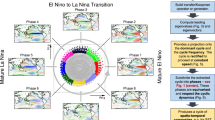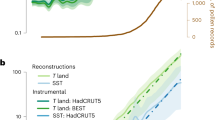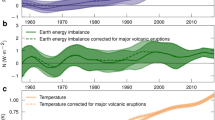Abstract
THE astronomical theory1 attributes long term changes in climate to changes in the Earth's orbital geometry. This theory has become increasingly accepted in recent years. To this acceptance, workers associated with the CLIMAP project have added exceptionally strong support2 using spectral analysis of deep-sea core data. They have linked periodicities in the Earth's orbital parameters with periodicities in deep-sea core parameters related to sea-surface temperature, ice volume and oceanic salinity. Their argument rests on the assumption of a linear response between input (radiation changes caused by changes in orbital geometry) and output (the climate-dependent parameters mentioned above). At the same time they have attributed the anomalously high variance associated with the longest periodicity (∼ 100,000 yr) to a nonlinear response. There is no contradiction here because the response function, the climate ‘black box’, most probably has both linear and nonlinear components. I examine here the question of nonlinear response in more detail.
This is a preview of subscription content, access via your institution
Access options
Subscribe to this journal
Receive 51 print issues and online access
$199.00 per year
only $3.90 per issue
Buy this article
- Purchase on Springer Link
- Instant access to full article PDF
Prices may be subject to local taxes which are calculated during checkout
Similar content being viewed by others
References
Milankovitch, M. Konigl. Serb. Akad. Beograd. Spec. Publ. 132 (1941), trans. by the Israel Program for Scientific Translations, Jerusalem, 1969.
Hays, J. D., Imbrie, J., and Shackleton, N. J., Science (in the press).
Gray, B. M., Q. Jl R. met. Soc., 102, 627 (1976).
Schneider, S. H., and Mass, C., Science 190, 741 (1975).
Harmon, R. S., Schwarcz, H. P., Ford, D. C., and Koch, D. L., Geology (in the press).
Duplessy, J.-C., Labeyrie, J., Lalou, C., and Nguyen, H. V., Nature, 226, 631 (1970).
Hendy, C., Geochim. cosmochim. Acta, 35, 801 (1971).
Schwarcz, H. P., Harmon, R. S., Thompson, P., and Ford, D. C., Geochim. cosmochim. Acta, 40, 657 (1976).
Johnsen, S. J., Dansgaard, W., Clausen, H. B., and Langway, C. C., Nature, 227, 482 (1970).
Bray, J. R., Nature, 220, 672 (1968).
Bray, J. R., Nature, 228, 353 (1970).
Denton, G. H., and Karlén, W., Quaternary Res., 3, 155 (1973).
Author information
Authors and Affiliations
Rights and permissions
About this article
Cite this article
WIGLEY, T. Spectral analysis and the astronomical theory of climatic change. Nature 264, 629–631 (1976). https://doi.org/10.1038/264629a0
Received:
Accepted:
Issue Date:
DOI: https://doi.org/10.1038/264629a0
This article is cited by
-
Reconstruction of atmospheric CO2 from ice-core data and the deep-sea record of ontong Java plateau: the Milankovitch chron
Geologische Rundschau (1996)
-
Time-series analysis in cyclic stratigraphy: An example from the Cretaceous of the Southern Alps, Italy
Mathematical Geology (1993)
-
Milankovitch climatic origin of mid-Cretaceous black shale rhythms in central Italy
Nature (1986)
Comments
By submitting a comment you agree to abide by our Terms and Community Guidelines. If you find something abusive or that does not comply with our terms or guidelines please flag it as inappropriate.



